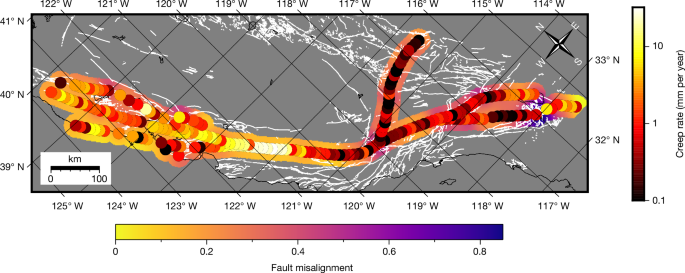Fault Network Geometry Shapes Earthquake Frictional Behavior in California
This article presents a new perspective on the factors governing the stability of fault slip, a crucial problem in fault mechanics. The study investigates the link between fault network geometry and surface creep rates in California, USA.
The key findings are:
- Fault groups exhibiting creeping behavior show smaller misalignment in their fault network geometry.
- The surface fault traces of creeping regions tend to be simple, whereas locked regions tend to be more complex.
- The presence of complex fault network geometries results in geometric locking that promotes stick-slip behavior characterized by earthquakes.
- Simpler fault geometries facilitate smooth fault creep.
These observations challenge traditional hypotheses that explain fault creep primarily in terms of fault friction. Instead, the authors propose a new framework where large-scale earthquake frictional behavior is determined by a combination of geometric factors and rheological yielding properties.
The study demonstrates the vital role of large-scale complexities in fault networks on the fault rupture process, going beyond previous lab experiments and numerical models that have focused on the importance of fault geometry and roughness on fault slip behavior.
Összefoglaló testreszabása
Átírás mesterséges intelligenciával
Hivatkozások generálása
Forrás fordítása
Egy másik nyelvre
Gondolattérkép létrehozása
a forrásanyagból
Forrás megtekintése
www.nature.com
Fault-network geometry influences earthquake frictional behaviour - Nature
Főbb Kivonatok
by Jaeseok Lee,... : www.nature.com 06-05-2024
https://www.nature.com/articles/s41586-024-07518-6
Mélyebb kérdések
